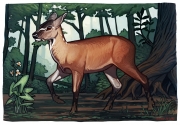The research follows decades of analysis in which paleontologists and biologists have examined dinosaur brain size and anatomy, and used these data to infer behavior and lifestyle. Information on dinosaur brains comes from mineral infillings of the brain cavity, termed endocasts, as well as the shapes of the cavities themselves.
In a surprising 2023 study, neurologist Dr Suzana Herculano-Houzel claimed that large carnivore dinosaurs like T. rex had an exceptionally high number of neurons and thus were substantially more intelligent than previously thought. Dr Herculano-Houzel argued that this high neuron count could be linked to intelligence, metabolism and life history, and that T. rex was perhaps rather monkey-like in some of its habits. Specifically, according to her analysis these dinosaurs were equipped with "macaque- or baboon-like cognition" and would have been able to craft and use tools and exhibit cultural behaviors.
The idea is really exciting, but apparently false. The new study, published in The Anatomical Record and led by Dr Kai Caspar (Heinrich Heine University, Düsseldorf, Germany), Dr Cristian Gutierrez-Ibanez (University of Alberta, Edmonton, Canada) and Dr Grant Hurlburt (Royal Ontario Museum, Toronto, Canada) looks at techniques used to predict both brain size and neuron numbers in dinosaur brains. The team found that previous assumptions about brain size in dinosaurs, and the number of neurons their brains contained, were unreliable.
The team found that Herculano-Houzel had overestimated brain size - especially that of the forebrain - and thus neuron counts as well. In addition, they show that neuron count estimates are just not a reliable guide to intelligence. “We argue that it’s not good practice to predict intelligence in extinct species when neuron counts reconstructed from endocasts are all we have to go on”, said Dr Caspar. “Neuron counts are not good predictors of cognitive performance, thus using them to predict intelligence in long-extinct species can lead to highly misleading interpretations”, said the team’s Dr Ornella Bertrand of the Institut Català de Paleontologia Miquel Crusafont (Catalonia, Spain).
What current data indicates, the team argues, is that dinosaurs like T. rex were not as intelligent as monkeys, but behaved more like crocodiles and lizards. Such animals are behaviourally complex and capable of feats that many experts regard as ‘intelligent’, so this should be by no means considered as an insult. In fact, it’s closer to the traditional view that dinosaurs were ‘reptile smart’.

Image 1. Relationship between brain and body mass in land-living vertebrates. Dinosaurs like T. rex have brain to body size ratios similar to those of living reptiles. (Credit: Cristian Gutierrez-Ibanez).
“The possibility that T. rex might have been as intelligent as a baboon is fascinating and terrifying, with the potential to reinvent our view of the past”, said Dr Darren Naish of the University of Southampton, “but our study shows how all the data we have is against this idea. They were more like smart giant crocodiles, and that’s just as fascinating”. “We thought that this article was needed because dinosaur research is very popular among the general public and a nuanced view of the cognitive capabilities of iconic animals such as T. rex is required”, Dr Caspar added.
To reliably reconstruct the biology of long-extinct species, the team argues, researchers should look at multiple lines of evidence, including skeletal anatomy, bone histology, and trace fossils.
Main image: Photograph of a T. rex skeletal cast at Senckenberg Museum Frankfurt, Germany. T. rex lived at the end of the Cretaceous (about 66 million years ago) and was exclusive to Western North America. (Credit: Kai R. Caspar).
Article original:
-
, , , , , , , , , , & (2024). How smart was T. rex? Testing claims of exceptional cognition in dinosaurs and the application of neuron count estimates in palaeontological research. The Anatomical Record, 1–32. DOI: https://doi.org/10.1002/ar.25459
















